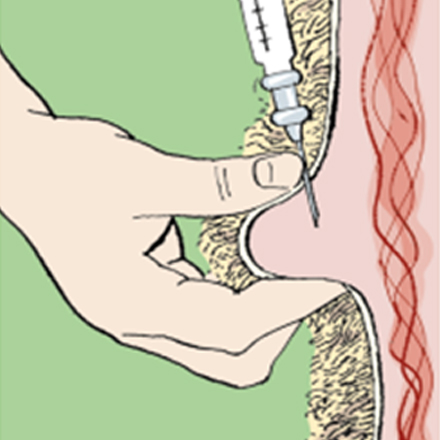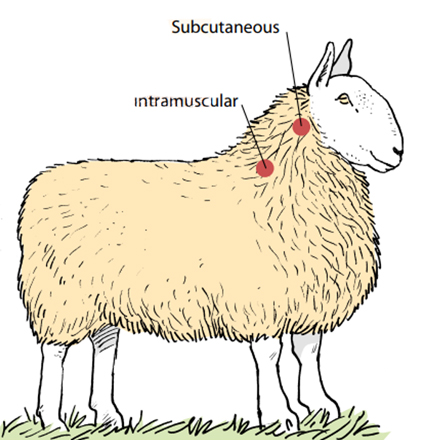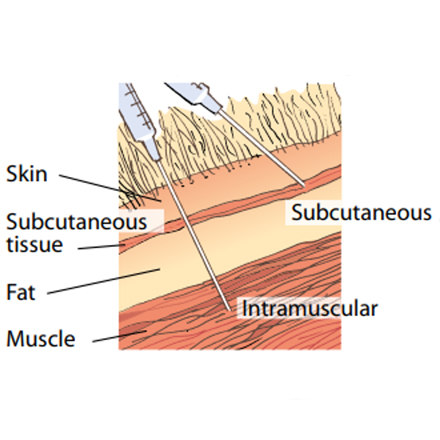Currently out of stock
Contact us >
This product is only licensed for sale in the Republic Of Ireland
Black Leg is for the active immunisation of cattle against diseases caused by Cl. chauvoei, Cl. septicum, Cl. novyi and Cl. tetani.
A serological response to Cl. haemolyticum is induced in susceptible cattle, but efficacy of this component has not been demonstrated in cattle.
It is applied at 2ml per animal.
Active substance(s):
Cl.chauvoei - strain No: 655, 656,657,658 and 1048.
Target Species
Cattle and Sheep
Treats and Controls
Diseases caused by Cl. chauvoei, Cl. septicum, Cl. novyi and Cl. tetani.
Application Method
Administration is by subcutaneous injection.
Withdrawal Period
Zero Days
Dosage
Sheep:
Basic vaccination:
Two injections, each of 2ml, separated by an interval of 4-6 weeks to be completed 2-3 weeks before onset of the period of risk.
Cattle:
Basic vaccination
Two injections, each of 2ml, separated by an interval of 4-6 weeks to be completed 2-3 weeks before onset of the period of risk.
This Product is only licensed for sale in the Republic of Ireland
Click here to Download Data Sheet
Summary of Product Characteristics
1 NAME OF THE VETERINARY MEDICINAL PRODUCT
BLACKLEG VACCINE
2 QUALITATIVE AND QUANTITATIVE COMPOSITION
For a full list of excipients, see section 6.1.
3 PHARMACEUTICAL FORM
Suspension for injection
4 CLINICAL PARTICULARS
4.1 Target Species
Sheep and cattle
4.2 Indications for use, specifying the target species
For the active immunisation of sheep and cattle to reduce mortality and clinical signs of blackleg disease caused by Clostridium chauvoei.
4.3 Contraindications
None.
Active substance(s): per dose (2 ml)
Cl.chauvoei - strain No: 655 2.50 x 108 cells & equivalent toxoid
656 2.50 x 108 cells & equivalent toxoid
657 2.50 x 108 cells & equivalent toxoid
658 2.50 x 108 cells & equivalent toxoid
1048 2.50 x 108 cells & equivalent toxoid
Adjuvant(s):
Aluminium hydroxide 400 mg
Preservative(s):
Thiomersal 0.26 mg
4.4 Special warnings for each target species
Do not vaccinate unhealthy animals.
When vaccinating pregnant animals, stress should be avoided particularly during the later stage of pregnancy.
4.5 Special precautions for use
Special precautions for use in animals
None.
Special precautions to be taken by the person administering the veterinary medicinal product to animals
In the case of accidental self injection or ingestion seek medical advice immediately and show the package leaflet or the label to the physician.
4.6 Adverse reactions (frequency and seriousness)
Vaccination of lambs may result in temporary swellings at the injection site lasting for up to 3-4 months after vaccination.
Typically, these swellings may be warm when compared to the surrounding area for up to 14 days after vaccination. Safety studies in lambs have shown that the swellings did not appear to inconvenience the animals or hinder neck movement.
Minor temperature increases (approximately 1°C – 2°C) lasting for up to 1 week may occur following vaccination of lambs.
No local or systemic reactions have been reported when vaccinating calves.
Occasional hypersensitivity reactions may occur.
4.7 Use during pregnancy, lactation or lay
The vaccine may be administered to pregnant sheep provided dosing is completed 4 –6 weeks prior to predicted lambing date. The vaccine cannot be administered to pregnant cows.
4.8 Interaction with other medicinal products and other forms of interaction
No information is available on the safety and efficacy from the concurrent use of this vaccine with any other. It is therefore recommended that no other vaccines should be administered within 14 days before or after vaccination with Blackleg Vaccine.
4.9 Amounts to be administered and administration route
Administration is by subcutaneous injection.
Sheep:
Basic vaccination Two injections, each of 2ml, separated by an interval of 4-6 weeks to be completed 2-3 weeks before onset of the period of risk.
Minimum age of vaccination is 3 weeks.
Re-vaccination scheme
Thereafter a 2ml booster injection at intervals of not more than 12 months.
Cattle:
Basic vaccination Two injections, each of 2ml, separated by an interval of 4-6 weeks to be completed 2-3 weeks before onset of the period of risk.
Minimum age of vaccination is 4 weeks.
Re-vaccination scheme Thereafter a 2ml booster injection at intervals of not more than 12 months.
Shake vaccine bottle well before use.
Do not freeze.
Syringes and needles should be from gamma irradiated packs or freshly sterilised by boiling for 20 minutes.
No alcohol or disinfectant should be used for this sterilisation procedure.
The use of an automatic vaccinator is recommended.
Since the bottle is non-collapsible, a vaccinator with a vented draw-off spike or similar device must be used.
The instructions supplied with such syringes should be noted and care should be taken to ensure the delivery of the full dose, particularly with the final few doses from the bottle.
4.10 Overdose (symptoms, emergency procedures, antidotes), if necessary
Accidental overdosage is unlikely to cause any reaction other than described in point 4.6.
4.11 Withdrawal Period(s)
Zero days.
5 PHARMACOLOGICAL or IMMUNOLOGICAL PROPERTIES
ATC vet code:
QI02AB01;
Pharmacotherapeutic group:
Clostridium vaccine (cattle)
Vaccine to stimulate active immunity against blackleg disease in sheep and cattle.
Onset of immunity: Significant levels of immunity cannot be expected until two weeks after the second dose of the primary vaccination course.
Duration of immunity: Active immunity to blackleg disease is expected to persist for up to one year.
6 PHARMACEUTICAL PARTICULARS
6.1 List of excipients
Aluminium hydroxide
Thiomersal
Formaldehyde
TRIS
Maleic Acid
Sodium chloride
Water for injection
6.2 Incompatibilities
Do not mix with any other immunological product.
6.3 Shelf-life
Shelf-life of the veterinary medicinal product as packaged for sale: 3 years Shelf-life after first opening the immediate packaging: 10 hours.
6.4 Special precautions for storage
Store in a refrigerator (2°C - 8°C). Do not freeze. Protect from light.
6.5 Nature and composition of immediate packaging
Carton with one low density polyethylene bottle containing 50 ml closed with a butylrubber disc (Intervet UK Ltd) or rubber stopper (Laboratorios Intervet, Salamanca) with aluminium overseal combination cap.
6.6 Special precautions for the disposal of unused veterinary medicinal products or waste materials
Any unused product or waste material should be disposed of in accordance with national requirements.
7 MARKETING AUTHORISATION HOLDER
Intervet Ireland Ltd.
Magna Drive
Magna Business Park
Citywest Road
Dublin 24
8 MARKETING AUTHORISATION NUMBER(S)
VPA 10996/142/001
9 DATE OF THE FIRST AUTHORISATION/RENEWAL OF THE AUTHORISATION
31st August 2007
10 DATE OF REVISION OF THE TEXT
January 2012
Cattle Injectables
Injectables should be given according to the manufacturer’s instructions at the recommended injection site.
• Always use a clean, sterile syringe and needle. If using a multiple injection gun, ensure the needle is disinfected between injections, e.g. with an automatic sterilisation system.
• If the site to be injected is dirty, clean the skin and swab with an alcohol-impregnated wipe or cotton wool.
• Before injecting, check the expiry date and read the instructions of the product to be used. Some products need to be shaken before use.
• Use the correct-sized needle according to the size of the animal and site of injection.
• Ensure the animal is adequately restrained before attempting the injection.
• Take care to ensure it is given subcutaneously and not intramuscularly. Raise a fold of skin at the injection site (mainly neck but some are ear) recommended by the product manufacturer and inject carefully into the space created.
• If a large dose is to be delivered, it may be advisable to split the dose between two injection sites. After the injection, briefly massage the site to improve the dispersal of the injected material.
• Dispose of the needle and syringe in appropriate clinical waste and sharps containers.

Sheep Subcutaneous injections
Subcutaneous injections need to be administered with care to ensure the product is placed under the skin and not into the fleece or muscle.
The sheep needs to be well restrained, and the skin ‘tented’ away from the underlying muscle.
The preferred injection site is 10–15 cm (4–6 inches) below the ear on the side of the neck (see diagram below). Usually a 1.6 cm (5/8 inch) needle is ideal.
After administration, the site should be gently massaged.


Would you like to send this voucher to the recipient via email?
Yes No